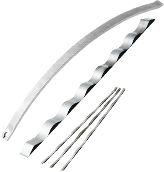Question Spring Newbie 2006/10/18(Wed) 9:29
When we made a disc spring prototype and oscillated it about 100 times, then a phenomenon occurred in which the spring deforms and the load decreased. We apologize for the inconvenience, but we will send you the specifications of the disc spring, the target load (first load, second load), and the disc spring specifications when the permanent deformation occurs. Please check and send us the optimum disc spring (plate thickness, material, processing, stacking method, etc.). Thank you in advance!
Answer Tokai Spring 2006/10/20(Fri) 14:34
Thank you for writing, Spring Newbie!
Regarding point (1) and (2), the point of the second load exceeds the allowable stress σc1960N/mm2, so stacking 1 disc spring in parallel will cause the permanent deformation. When using the same dimensions, it is necessary to stack 2 springs in parallel.
Regarding (3), the points of the first and second loads exceed the allowable stress σc2550N/mm2, so the sagging occurs. In order to satisfy the load, the plate thickness must be 0.5 mm or more.
Answer Spring Newbie 2006/10/21(Sat) 8:49
Thank you for your response.
Of course, to improve the springs’ performance, there are spring calculation formulas, the deflection-load diagram, deflection-stress diagram, etc. But I still don’t understand why I should use two springs in parallel? Why should the plate thickness be 0.5 mm or more? Is it possible to find materials from those basic methods? (calculation results, graphs, etc.)
Answer Tokai Spring 2006/10/23(Mon) 17:37
Hello again! Regarding the calculation basis, we will send you the calculation form directly by e-mail!
We are happy to answer any inquiries regarding technology, specifications, materials, etc. Please feel free to ask.

















